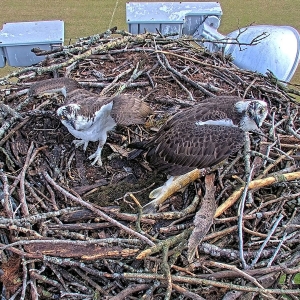Video feed captures ospreys nesting on campus after long-distance migration

By Bob Sheehy, Ph.D.
Emeritus Professor of Biology
In early March, ospreys returned to Radford University, continuing a tradition of nesting on our main campus this time of year. Clyde Kessler, a local ornithologist, first observed the nest in May 2019. It has been active every year since. In anticipation of the birds’ return migration, a camera was installed on the nest through a collaborative effort involving the Departments of Biology and Geology, University Advancement, Facilities Management, Information Technology Services and Marketing and Communication, and with the support of CMG Leasing.
Osprey (Pandion haliaetus) are birds of prey that are almost exclusively fish eaters. In higher latitudes, fish become unavailable in winter, so the birds in these areas migrate. Our birds are likely migrating to the Caribbean or South America each winter and returning for nesting in mid-March to early April.
Ospreys form permanent pairings and will return to use the same nest year after year. The nesting season starts with the pair adding to the nest, which increases in size each year, often becoming quite large. Copulations take place in the nest, and the female will lay two to four eggs several days apart. While incubation is done primarily by the female, the male will help with this task as well. Incubation lasts approximately 40 days. Young ospreys grow quickly and are ready to fledge about 2 ½ months after hatching. Highlanders who tune into the video feed will be able to distinguish the male from the female osprey based on size. The females are noticeably larger than the males.
One of only six species of land birds with worldwide distribution, the osprey population decreased by an estimated 90% in the 1950s and ’60s due to the widespread use of pesticides such as DDT. Since the U.S. ban on DDT in 1972, the population of ospreys has been slowly increasing. Radford University has seen the benefit of this increase and strives to support this conservation effort as part of the River Campus initiative. The installation of artificial nest platforms has been shown to aid in this recovery effort, and members of the university community, in partnership with the city, are exploring the construction of additional nesting sites along Radford's riverway.
You can help Radford University name the ospreys and be part of our history.
NOTE: The safety and well-being of the ospreys are of paramount importance, so please respect their rights to nest without human interference. We encourage members of the Radford community to observe these birds via the video feed. Harassing nesting ospreys violates the Federal Migratory Bird Act, and shooting drone video footage of the birds in their nesting habitat or disturbing them in any other way is strictly prohibited.